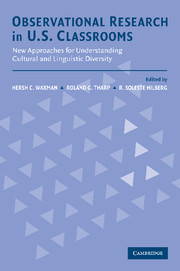 Observational Research in U.S. Classrooms
Observational Research in U.S. Classrooms Published online by Cambridge University Press: 23 November 2009
This chapter reports on the theoretical conceptualization, development, and measurement properties of an observation instrument for coding classroom instructional activities. This required the examination of several fundamental issues concerning sociocultural theory as it relates to schooling. These issues are presented through a discussion of the relationships between theory, method, and analysis used in the development of a training program for observing, analyzing, and quantifying classroom activities.
In the past two decades, we have seen many treatments of activity theory in the field of education. From the sociocultural perspective, many interesting and useful constructs have been proposed to capitalize on these ideas. However, the accumulation of empirical research has been retarded by the lack of suitable quantifying instruments. In our view, as important as all these ideas are in the field of education, they serve no one well if they don't promote active empirical research.
Most of the critical data in sociocultural theory have been qualitative, and many have been thick ethnographic and discourse analytic descriptions. Critics of sociocultural theory often object to the lack of objective, quantifiable methods that are more typical of sociologists and psychologists. In particular, much work on activity theory in education has relied on thick observation, but applications in real educational settings have been minimal because there are no instruments for broader use that allow for more studies of a different kind. Sociocultural theorists have asked: Can a thin system for observing and quantifying sociocultural activities be developed?
To save this book to your Kindle, first ensure [email protected] is added to your Approved Personal Document E-mail List under your Personal Document Settings on the Manage Your Content and Devices page of your Amazon account. Then enter the ‘name’ part of your Kindle email address below. Find out more about saving to your Kindle.
Note you can select to save to either the @free.kindle.com or @kindle.com variations. ‘@free.kindle.com’ emails are free but can only be saved to your device when it is connected to wi-fi. ‘@kindle.com’ emails can be delivered even when you are not connected to wi-fi, but note that service fees apply.
Find out more about the Kindle Personal Document Service.
To save content items to your account, please confirm that you agree to abide by our usage policies. If this is the first time you use this feature, you will be asked to authorise Cambridge Core to connect with your account. Find out more about saving content to Dropbox.
To save content items to your account, please confirm that you agree to abide by our usage policies. If this is the first time you use this feature, you will be asked to authorise Cambridge Core to connect with your account. Find out more about saving content to Google Drive.